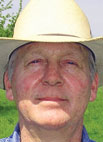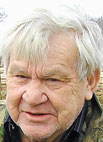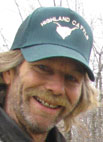Raising Better Cattle
Some cattlemen raise cattle with the consumer in mind, while others focus on the feedlot operator, and still others have their own family in mind. Lonnie McWilliams is a little of everything. Lonnie’s ranch, KD Gelbvieh, is located just west of Sheldon, Mo. KD used to stand for Katie and Dad, and it still does, although “Dad” is the main operator now. When she was in 4-H and FFA, Katie had a lot of success showing their cattle and crossbred hogs. Now, Katie’s kids have their own calves to show. Lonnie and his wife Lora run about 70 cows on their 270-acre farm. Their herd is mostly Registered Red Gelbvieh, though they have a few Charolais and some balancers.
Both Sheriff and Farmer
Bob Dotson was born into farming. He still owns the 190 acres and the home he grew up in, as well as two other land parcels of 80 and 20 acres, where he keeps approximately 50 cows. He has a mixed breed herd of mostly black Angus. He also puts up 400 bales of hay each year.
The Farming Life
In 1919 Alfred Friend bought a farm in Dade County, Missouri, bordering Stockton Lake, from the Sloan family. It was just under a section of land, at 640 acres. At Alfred’s side during the purchase was his son, J.A. Friend. Together the two began to farm the bottom land. They raised cattle, hogs and row crops of corn, wheat and beans. Alfred lived in one house on the farm and J.A. in another house down the hill.
All-Natural Ways
Scott and Pam Powers believe in supporting local agriculture, and in the process, they're growing the best tasting broiler chickens and meat rabbits in Ozark County, Missouri. Their method is to use no additives or preservatives in raising their animals, and they do it all on their small acreage.
Thanks To The Lambs
"Each species of livestock has its own little differences,” Scott Kaden explained recently, while standing inside a barnful of bleeting Hampshire and Dorset sheep in Phelps County, a short distance south of Rolla, Mo.
Beefmasters Breed Better
Some cattlemen select their breed of cattle after carefully considering all the characteristics of a particular breed, and then choosing the one that suits their tastes best. However, some producers are not satisfied with the characteristics any single breed can offer them. One alternative for those producers who want more is to select a breed like Beefmasters.
Trying A Living Fence
When New England poet Robert Frost penned, "Good fences make good neighbors," he wasn't thinking about trees.
Foraging Ability
Lightening Ridge Farm is a long way from the Scottish Highlands, but the terrain and weather conditions haven’t been much different here in the Missouri Ozarks. Near the southern line of Texas County, on the headwaters of Jack’s Fork River, the hills are steep and live water from springs is abundant. Dave and Ruth Embry raise Highland cattle on their 150-acre farm that is mostly wooded with about 20 acres open. You might think it would be impossible to raise livestock in these conditions, but their Highland cattle are thriving here.
Keeping The Farm
Juanita “Janie” Martinez Perez is a woman whose hands are very full. She's the owner and operator of a 165-acre dairy farm with 39 Holstein cows, 14 heifers, 8 calves and 10 horses, the mother of a 14-year-old son whom she home schools and she's newly widowed.
Goats and Self-Sufficiency
"We wanted to move towards being self-sustaining,” said Crystal Eutsler when asked about why she got started with production agriculture when neither she nor her husband, Chad, had grown up on a farm. Thirteen years ago when Crystal’s family moved to Bois D’Arc, Mo., she bought some chickens. Soon her son, Ethan, took an interest in his junior high FFA chapter, and wanted to start a project. A small goat herd was the result. Crystal had helped her son, Ethan, buy three Boer goats. At the end of the project, they had 16 goats. “We loved having goats, but that particular breed required a little more care and upkeep than we had the time for, so we sold those and were introduced into the French Alpine breed by a friend,” said Crystal.











